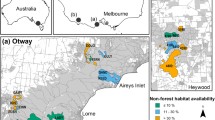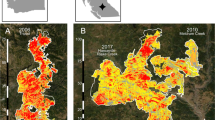Abstract
Fuel management for wildfire protection is becoming increasingly common in the wildland–urban interface and may have conservation implications for species with restricted distributions and limited dispersal abilities. To evaluate the impact of forest fuel management on the damselfly Argia vivida at the northern margin of its range, we examined terrestrial movements and habitat associations using Capture-Mark-Recapture and point count techniques. We found that habitats away from the springs were particularly important for A. vivida females. Most damselflies travelled at least 50 m between capture and recapture and patches of cleared forest up to this size did not pose a barrier to movement. Although A. vivida typically roosts in trees at night, cleared fuel treatment areas were preferred over unmodified or thinned forest as daytime basking and foraging sites. Preferred sites were also characterized by heterogeneous canopy closure, i.e., a clearing adjacent to unmodified forest with a closed canopy. We speculate that this behaviour derives from the species’ thermoregulation requirements; the use of sunspots for thermal basking during the day and the use of forest cover at night to slow the radiant loss of heat. Our findings demonstrate the scale of movements that define available habitat and the importance of both daytime and night time habitat requirements in considering terrestrial foraging and movement corridors. Consequently, conservation efforts for this species in fuel management areas should focus on maintaining unmodified stands of dense trees in association with cleared patches of appropriate dimension, rather than a uniformly thinned forest.


Similar content being viewed by others
References
Acorn J (2004) Damselflies of Alberta. The University of Alberta Press, Edmonton
Agee JK, Bahro B, Finney MA, Omi PN, Sapsis DB, Skinner CN, van Wagtendonk JW, Weatherspoon CP (2000) The use of fuelbreaks in landscape fire management. For Ecol Manag 127:55–66
Anderson DR, Burnham KP, Thompson WL (2000) Null hypothesis testing: problems, prevalence and an alternative. J Wildl Manag 64:912–923
Angelibert S, Giani N (2003) Dispersal characteristics of three odonate species in a patchy habitat. Ecography 26:13–20
Apigian KO, Dahlsten DL, Stephens SL (2006) Fire and fire surrogate treatment effects on leaf litter arthropods in a western Sierra Nevada mixed-conifer forest. For Ecol Manag 221:110–122
Banks MJ, Thompson DJ (1985) Lifetime mating success in the damselfly Coenagrion puella. Anim Behav 33:1175–1183
Beirinckx K, Van Gossum H, Lajeunesse J, Forbes MR (2006) Sex biases in dispersal and philopatry: insights from a meta-analysis based on capture-mark-recapture studies of damselflies. Oikos 113:539–547
Bilton DT, Freeland JR, Okamura B (2001) Dispersal in freshwater invertebrates. Ann Rev Ecol Syst 32:159–181
Bried JT, Ervin GN (2006) Abundance patterns of dragonflies along a wetland buffer. Wetlands 26:878–883
Bunnel FL (1995) Forest-dwelling vertebrate faunas and natural fire regimes in British Columbia: patterns and implications for conservation. Conserv Biol 9:636–644
Burnham KP, Anderson DR (2002) Model selection and multi-model inference: a practical information-theoretic approach. Springer, New York
Cannings RA, Cannings SG, Ramsay L (2000) The dragonflies (Insecta: Odonata) of the Columbia Basin, British Columbia: field surveys, collections development and public education. Royal British Columbia Museum. Available via the British Columbia Conservation Data Centre. http://www.env.gov.bc.ca/cdc/. Accessed 25 July 2008
Chen Z, Grady K, Stephens S, Villa-Castillo J, Wagner MR (2006) Fuel reduction treatment and wildfire influence on carabid and tenebrionid community assemblages in the ponderosa pine forest of northern Arizona, USA. For Ecol Manag 225:168–177
Conrad KF, Pritchard G (1988) The reproductive behavior of Argia vivida Hagen: an example of a female-control mating system (Zygoptera: Coenagrionidae). Odonatologica 17:179–185
Conrad KF, Willson KH, Whitfield K, Harvey IF, Thomas CJ, Sherratt TN (2002) Characteristics of dispersing Ischnura elegans and Coenagrion puella (Odonata): age, size, sex, morph and ectoparasitism. Ecography 25:439–445
Converse SJ, White GC, Farris KL, Zack S (2006) Small mammals and forest fuel reduction: national-scale responses to fire and fire surrogates. Ecol Appl 16:1717–1729
Corbet PS (1999) Dragonflies: behaviour and ecology of Odonata. Cornell University Press, New York
Delibes M, Ganona P, Ferreras P (2001) Effects of an attractive sink leading into maladaptive habitat selection. Am Nat 158:277–285
Dellasala DA, Williams JE, Williams CD, Franklin JF (2004) Beyond smoke and mirrors: a synthesis of fire policy and science. Conserv Biol 18:976–986
Foster SE, Soluk DA (2006) Protecting more than the wetland: the importance of biased sex ratios and habitat segregation for conservation of the Hine’s emerald dragonfly, Somatochlora hineana Williamson. Biol Conserv 127:158–166
Gallant AL, Hansen AJ, Councilman JS, Monte DK, Betz DW (2003) Vegetation dynamics under fire exclusion and logging in a Rocky Mountain watershed, 1856–1996. Ecol Appl 13:385–403
Hornung CLR, Pacas C (2006) Investigating damselfly populations at springs in Banff National Park, Canada, with special focus on Argia vivida, Amphiagrion abbreviatum, and Ischnura cervula (Odonata: Coenagrionidae). Aquat Ecol 40:49–58
Hosmer DW, Lemeshow S (2000) Applied logistic regression, 2nd edn. Wiley, New York
Houston DB (1973) Wildfires in northern Yellowstone National Park. Ecology 54:1111–1117
Ingvarsson PK (2001) Restoration of genetic variation lost—the genetic rescue hypothesis. Trends Ecol Evol 16:62–63
Jonsen ID, Taylor PD (2000a) Fine-scale movement behaviours of calopterygid damselflies are influenced by landscape structure: an experimental manipulation. Oikos 88:553–562
Jonsen I, Taylor PD (2000b) Calopteryx damselfly dispersions arising from multiscale responses to landscape structure. Conserv Ecol 4:57–76
Keating KA, Cherry S (2004) Use and interpretation of logistic regression in habitat-selection studies. J Wildl Manag 68:774–789
Kirkton SD, Schultz TD (2001) Age-specific behaviour and habitat selection of adult male damselflies, Calopteryx maculata (Odonata: Calopterygidae). J Insect Behav 14:545–556
Legott M, Pritchard G (1986) Thermal preference and activity thresholds in populations of Argia vivida (Odonata: Coenagrionidae) from habitats with different thermal regimes. Hydrobiologia 140:85–92
McRae DJ, Duchesne LC, Freedman B, Lynham TJ, Woodley S (2001) Comparisons between wildfire and forest harvesting and their implications in forest management. Environ Rev 9:223–260
Mitchell R (1962) Storm-induced dispersal in the damselfly Ischnura Verticalis (Say). Am Midl Nat 68:199–202
Moghaddas JJ, Craggs L (2007) A fuel treatment reduces fire severity and increases suppression efficiency in a mixed conifer forest. Int J Wildland Fire 16:673–678
Pritchard G (1971) Argia vivida (Odonata: Coenagrionidae) in hot pools at Banff. Can Fld Nat 85:187–188
Pritchard G (1988) The dragonflies of the Cave and Basin Hot Springs, Banff National Park, Canada. Notul Odonatol 3:8–9
Pritchard G (1989) The roles of temperature and diapause in the life history of a temperate-zone dragonfly: Argia vivida (Odonata: Coenagrionidae). Ecol Entomol 14:99–108
Pritchard G, Kortello A (1997) Roosting, perching and habitat selection in Argia vivida Hagen and Amphiagrion abbreviatum (Selys) (Odonata: Coenagrionidae), two damselflies inhabiting geothermal springs. Can Entomol 129:733–743
Purse BV (2001) The ecology and conservation of the southern damselfly (Coenagrion mercurial). Ph.D Thesis. University of Liverpool, Liverpool
Purse BV, Hopkins GW, Day KJ, Thompson DJ (2003) Dispersal characteristics and management of a rare damselfly. J Appl Ecol 40:716–728
Rouquette JR, Thompson DJ (2007a) Patterns of movement and dispersal in an endangered damselfly and the consequences for its management. J Appl Ecol 44:692–701
Rouquette JR, Thompson DJ (2007b) Roosting site selection in the endangered damselfly, Coenagrion mercurial, and implications for habitat design. J Insect Conserv 11:187–193
Shelley TE (1982) Comparative foraging behavior of light versus shade-seeking adult damselflies in a lowland neotropical forest (Odonata: Zygoptera). Physiol Zool 55:335–343
Stephens SL, Ruth LW (2005) Federal forest fire policy in the United States. Ecol Appl 15:532–542
Stratton RD (2004) Assessing the effectiveness of landscape fuel treatments on fire growth and behavior. J For 102:32–40
Thomas CD, Hanski I (1997) Butterfly metapopulations. In: Hanski I, Gilpin ME (eds) Metapopulation biology: ecology, genetics and evolution. Academic Press, London, pp 359–386
Van Dyck H, Baguette M (2005) Dispersal behaviour in fragmented landscapes: routine or special movements? Basic Appl Ecol 6:535–545
Watts PC, Rouquette JR, Saccheri IJ, Kemp SJ, Thompson DJ (2004) Molecular and ecological evidence for small-scale isolation by distance in an endangered damselfly, Coenagrion mercuriale. Mol Ecol 13:2931–2945
Westfall MJ, May ML (1996) Damselflies of North America. Scientific Publishers, Gainesville
Acknowledgments
Funding for this research came from Parks Canada. We thank Ian Pengelly for his support of this project. Field data was collected with the help of Steve Bertollo. Dwayne and Brenda Lepitzki contributed useful observations and Gordon Pritchard provided helpful suggestions on the manuscript.
Author information
Authors and Affiliations
Corresponding author
Rights and permissions
About this article
Cite this article
Kortello, A.D., Ham, S.J. Movement and habitat selection by Argia vivida (Hagen) (Odonata, Coenagrionidae) in fuel-modified forest. J Insect Conserv 14, 133–140 (2010). https://doi.org/10.1007/s10841-009-9233-2
Received:
Accepted:
Published:
Issue Date:
DOI: https://doi.org/10.1007/s10841-009-9233-2




